Quickstart Angular
Intro
This example will show you how to build a simple user management app from scratch using Kontenbase and Angular. Before begin make sure that you are familiar with Angular basics.
This also includes:
- Kontenbase Database: to store data, such as users and profiles.
- Kontenbase SDK: this will make easier to handle auth and service features.
- Kontenbase Authentication & Authorization: users can sign in with username and password.
- Kontenbase Storage: users can upload a photo.
By the end, you'll have an application that is able to register a new user, login and update some basic profile details.
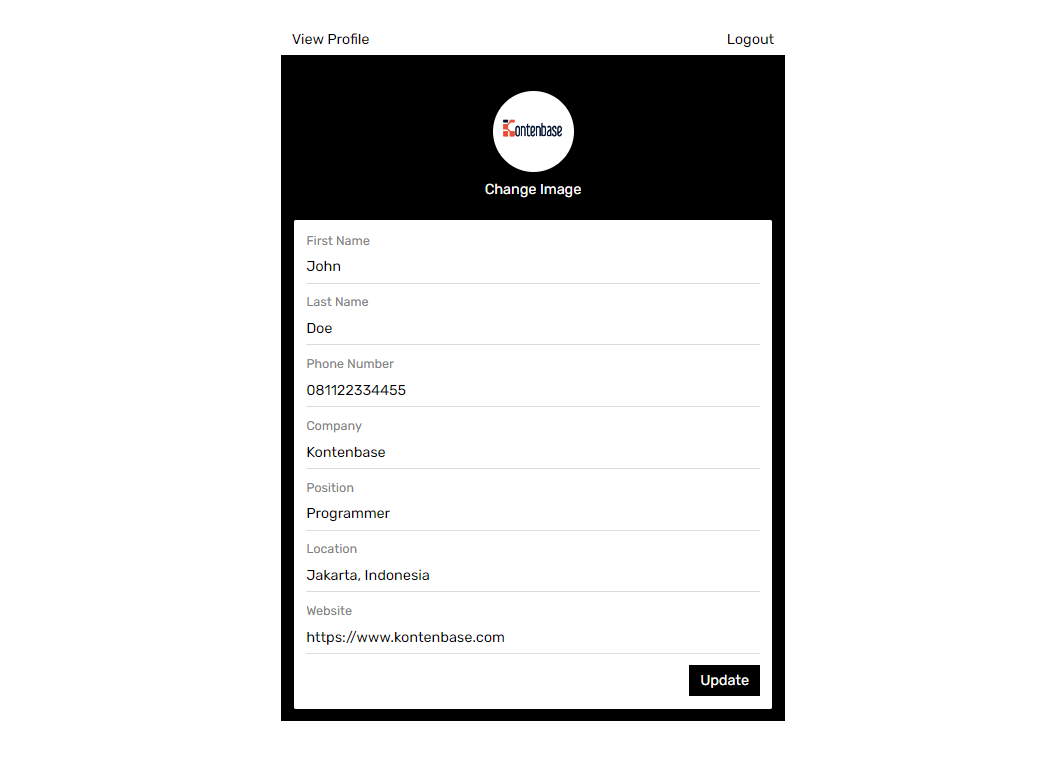
Project Set up
Before we start building we're going to set up our Database and get the API KEY.
Create a Project
- Go to app.kontenbase.com
- Click on
Create Projectbutton. - Enter your project details.
- Wait for the new project to launch.
Set up the Database Service
Now we are going to set profile and Users service.
- Click on
Create New Servicebutton. - Fill in the service detail, give a name
profile, select as private. - Click on
profileservice, selectCustomize Fields, then add some fields following picture below. note, there is a fieldUserswith data typeLink To Record. It means we create a data relation between the serviceprofilewith theUsers.
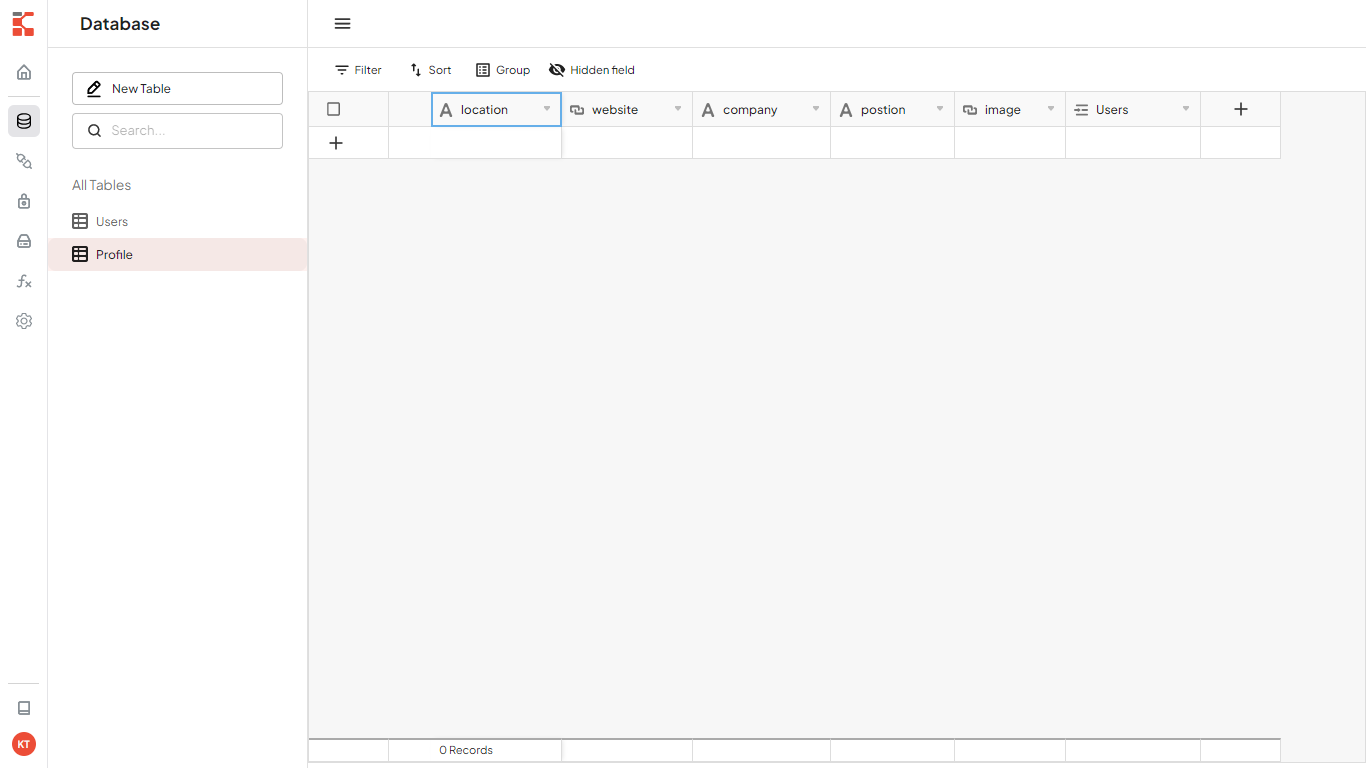
We need some configuration in Users service to make both autheticated user and public can get or access users data. But don't worry, by default that will not return password, so user still secure.
- Click on
Authorizationbutton. - Change service to
Usersand turn onGETpermission for role autheticated and public.
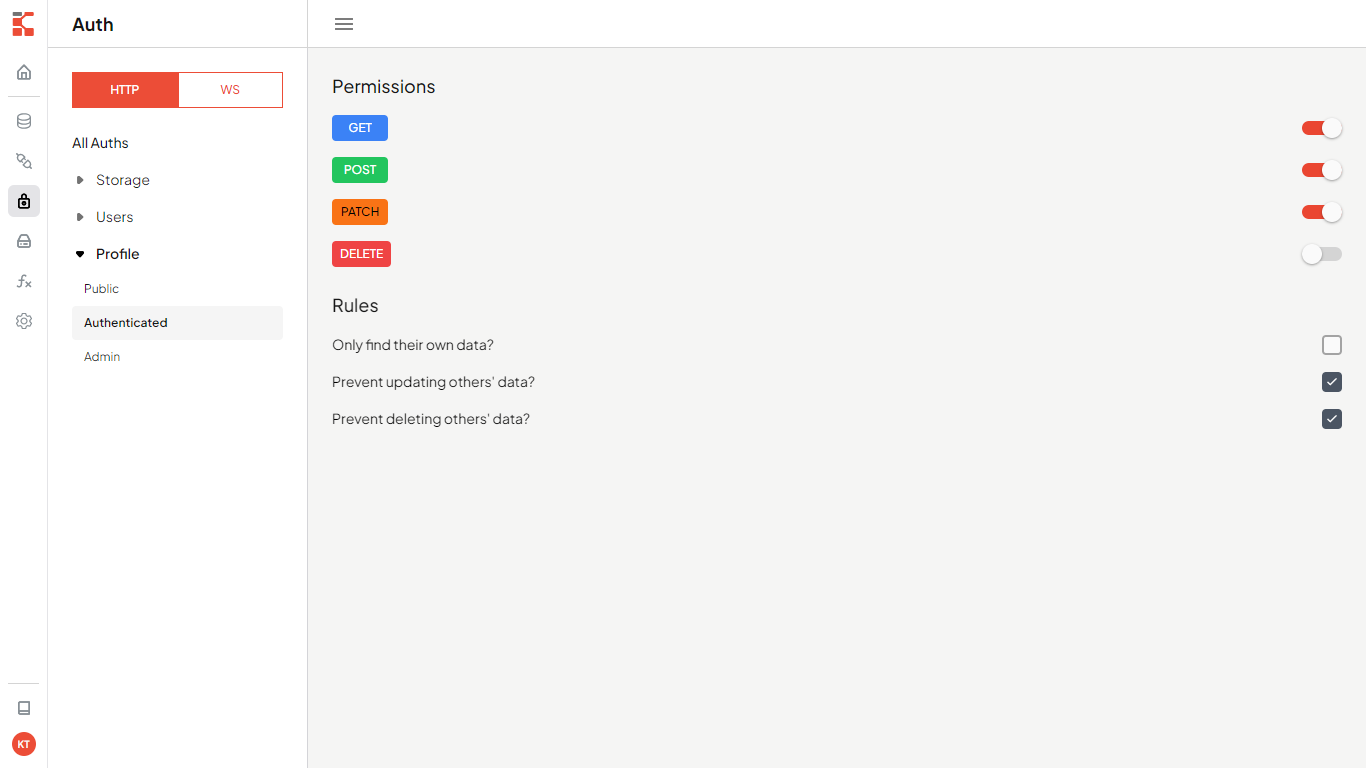
- Add new field called :
username, select data type :username, then set field as required and unique. - Enable username as user identity when logging in: click
Settings, thenConfigurationon the sidebar, findUser identity fieldand change to username.
Get the API KEY
- Go to the
Settings. - Click
APIon the sidebar. - Find your API KEY in this page.
Building the App
Initialize an Angular App
We can use the Angular CLI to initialize an app called kontenbase-angular:
npx ng new kontenbase-angular --routing true --style css
cd kontenbase-angular
Let's install Kontenbase SDK, simply use the command below:
npm install @kontenbase/sdk
Save the API KEY to environment variable in a environments/environment.ts that you copied earlier.
export const environment = {
production: false,
kontenbaseApiKey: YOUR_API_KEY,
};
Once that is done, let's create a helper file to initialize the Kontenbase Client and configure your SDK with the API KEY:
import { Injectable } from '@angular/core';
import { createClient } from '@kontenbase/sdk';
import { environment } from '../environments/environment';
interface Profile {
company?: string;
location?: string;
position?: string;
website?: string;
}
@Injectable({ providedIn: 'root' })
export class KontenbaseService {
private kontenbase: any;
constructor() {
this.kontenbase = createClient({
apiKey: environment.kontenbaseApiKey,
});
}
get user() {
return this.kontenbase.auth.user();
}
login(username: string, password: string) {
return this.kontenbase.auth.login({
// @ts-ignore
username,
password,
});
}
register(
firstName: string,
lastName: string,
email: string,
username: string,
password: string
) {
return this.kontenbase.auth.register({
firstName,
lastName,
email,
// @ts-ignore
username,
password,
});
}
createProfile(userId: string) {
return this.kontenbase.service('profile').create({
Users: [userId],
});
}
getOwnProfile() {
return this.kontenbase.auth.user({
lookup: '*',
});
}
updateUser(firstName: string, lastName: string, phoneNumber: string) {
return this.kontenbase.auth.update({ firstName, lastName, phoneNumber });
}
uploadImage(file: string) {
return this.kontenbase.storage.upload(file);
}
updateImage(profileId: string, image: string | undefined) {
return this.kontenbase.service('profile').updateById(profileId, {
image,
});
}
updateProfile(
id: string,
company: string,
location: string,
position: string,
website: string
) {
let profileData: Profile = {
company: '',
location: '',
position: '',
};
profileData.company = company;
profileData.location = location;
profileData.position = position;
if (website !== '') {
profileData.website = website;
}
return this.kontenbase.service('profile').updateById(id, profileData);
}
getProfileByUsername(username: string | undefined) {
return this.kontenbase.service('Users').find({
where: {
username,
},
lookup: '*',
});
}
logout() {
return this.kontenbase.auth.logout();
}
}
also import angular features that we will need, copy the code below:
import { NgModule } from '@angular/core';
import { FormsModule, ReactiveFormsModule } from '@angular/forms';
import { BrowserModule } from '@angular/platform-browser';
import { AppRoutingModule } from './app-routing.module';
import { AppComponent } from './app.component';
@NgModule({
declarations: [AppComponent],
imports: [BrowserModule, AppRoutingModule, FormsModule, ReactiveFormsModule],
providers: [],
bootstrap: [AppComponent],
})
export class AppModule {}
then create routing for our App.
import { NgModule } from '@angular/core';
import { RouterModule, Routes } from '@angular/router';
const routes: Routes = [];
@NgModule({
imports: [RouterModule.forRoot(routes)],
exports: [RouterModule],
})
export class AppRoutingModule {}
Remove all code inside app.component.html leave only <router-outlet></router-outlet> tag.
<router-outlet></router-outlet>
An optional step is updating the CSS file to make the App look nice. copy the css code that we have provided below to styles.css:
@import url('https://fonts.googleapis.com/css2?family=Rubik:wght@300;400;500;600;700&display=swap');
* {
margin: 0;
padding: 0;
box-sizing: border-box;
font-family: 'Rubik', sans-serif;
}
a {
text-decoration: none;
}
button,
.button {
color: black;
background-color: transparent;
border: none;
padding: 8px 12px;
font-size: 16px;
cursor: pointer;
}
.button-ouline {
border: 1px solid gainsboro;
}
.button-primary {
background-color: black;
color: white;
}
.auth-page {
margin: 0 auto;
width: 560px;
padding: 14px;
}
.auth-button {
text-align: right;
margin-bottom: 16px;
}
.auth-page h2 {
text-align: center;
}
.form-group {
margin-bottom: 12px;
font-size: 16px;
}
.form-group label {
display: block;
margin-bottom: 4px;
font-weight: 500;
font-size: 16px;
text-align: left;
}
.form-group input {
padding: 8px 12px;
width: 100%;
font-size: 16px;
}
.form-button {
text-align: right;
}
.profile-page {
margin: 0 auto;
width: 560px;
}
.profile-wrapper {
background-color: black;
padding: 14px;
color: white;
}
.profile-header {
text-align: center;
padding: 24px 0;
}
.profile-title {
margin: 8px 0;
font-size: 24px;
font-weight: 600;
text-transform: capitalize;
}
.image-avatar {
border-radius: 50px;
}
.card {
background-color: white;
color: black;
border-radius: 2px;
padding: 14px;
}
.card:not(:last-child) {
margin-bottom: 12px;
}
.card h3 {
font-weight: 500;
margin-bottom: 24px;
}
.card-field:not(:last-child) {
margin-bottom: 12px;
}
.card-field input {
font-size: 16px;
}
.card span,
.card label {
display: block;
font-size: 14px;
color: gray;
margin-bottom: 4px;
}
.card input {
display: block;
font-family: 16px;
padding: 8px 8px 8px 0;
color: black;
width: 100%;
border: none;
border-bottom: 1px solid gainsboro;
outline: none;
}
.website-link {
text-decoration: none;
color: black;
}
.logout-button {
text-align: end;
}
input[type='file'] {
display: none;
}
.label-file {
display: flex;
flex-direction: column;
align-items: center;
margin-top: 2px;
cursor: pointer;
}
.label-file span {
margin-top: 10px;
}
.button-top {
display: flex;
justify-content: space-between;
}
.link-email {
text-decoration: none;
color: black;
}
Set up Login and Register Components
Let's set up the angular components to manage login and register. We'll use username and password to login.
Create a folder which will be called parts, then create login.component.ts and register.component.ts file inside that folder and copy the code below in each files.
import { Component } from '@angular/core';
import { Router } from '@angular/router';
import { KontenbaseService } from '../kontenbase.service';
@Component({
selector: 'login',
template: `
<form>
<input type="hidden" name="operation" value="login" />
<div class="form-group">
<label>Username</label>
<input #username type="text" name="username" required />
</div>
<div class="form-group">
<label>Password</label>
<input #password type="password" name="password" required />
</div>
<div class="form-button">
<button
type="submit"
(click)="handleLogin(username.value, password.value)"
class="button button-primary"
>
Submit
</button>
</div>
</form>
`,
})
export class LoginComponent {
constructor(
private readonly kontenbase: KontenbaseService,
private router: Router
) {}
handleLogin = async (username: string, password: string) => {
const { error, token } = await this.kontenbase.login(username, password);
if (error) {
alert(error.message);
return;
}
if (token) {
this.router.navigate(['/profile']);
}
};
}
import { Component } from '@angular/core';
import { Router } from '@angular/router';
import { KontenbaseService } from '../kontenbase.service';
@Component({
selector: 'register',
template: `
<form>
<div class="form-group">
<label>First Name</label>
<input #firstName type="text" name="firstname" required />
</div>
<div class="form-group">
<label>Last Name</label>
<input #lastName type="text" name="lastname" />
</div>
<div class="form-group">
<label>Username</label>
<input #username type="text" name="username" required />
</div>
<div class="form-group">
<label>Email</label>
<input #email type="email" name="email" required />
</div>
<div class="form-group">
<label>Password</label>
<input #password type="password" name="password" required />
</div>
<div class="form-button">
<button
(click)="
handleRegister(
firstName.value,
lastName.value,
email.value,
username.value,
password.value
)
"
class="button button-primary"
>
Submit
</button>
</div>
</form>
`,
})
export class RegisterComponent {
constructor(
private readonly kontenbase: KontenbaseService,
private router: Router
) {}
handleRegister = async (
firstName: string,
lastName: string,
email: string,
username: string,
password: string
) => {
const { user, error } = await this.kontenbase.register(
firstName,
lastName,
email,
username,
password
);
if (error) {
alert(error.message);
return;
}
const { error: errorProfile } = await this.kontenbase.createProfile(
user._id
);
if (errorProfile) {
alert(errorProfile.message);
return;
}
this.router.navigate(['/profile']);
};
}
Create home.component.ts file inside the app folder, this will import login and register components. Copy the code below:
import { Component } from '@angular/core';
@Component({
template: `
<div class="auth-page">
<div class="auth-button">
<button (click)="setSwitchAuthForm('login')">Login</button>
<button (click)="setSwitchAuthForm('register')">Register</button>
<div>
<login *ngIf="switchAuthForm === 'login'"></login>
<register *ngIf="switchAuthForm === 'register'"></register>
</div>
</div>
</div>
`,
})
export class HomeComponent {
switchAuthForm = 'login';
setSwitchAuthForm(authName: string) {
this.switchAuthForm = authName;
}
}
then declaration login, register and home components :
import { NgModule } from '@angular/core';
import { FormsModule, ReactiveFormsModule } from '@angular/forms';
import { BrowserModule } from '@angular/platform-browser';
import { AppRoutingModule } from './app-routing.module';
import { AppComponent } from './app.component';
import { LoginComponent } from './parts/login.component';
import { RegisterComponent } from './parts/register.component';
import { HomeComponent } from './home.component';
@NgModule({
declarations: [
AppComponent,
LoginComponent,
RegisterComponent,
HomeComponent,
],
imports: [BrowserModule, AppRoutingModule, FormsModule, ReactiveFormsModule],
providers: [],
bootstrap: [AppComponent],
})
export class AppModule {}
Create a route for Home page.
import { NgModule } from '@angular/core';
import { RouterModule, Routes } from '@angular/router';
import { HomeComponent } from './home.component';
const routes: Routes = [
{
path: '',
component: HomeComponent,
},
];
If we launch the App after doing the steps above, We'll see this page show:
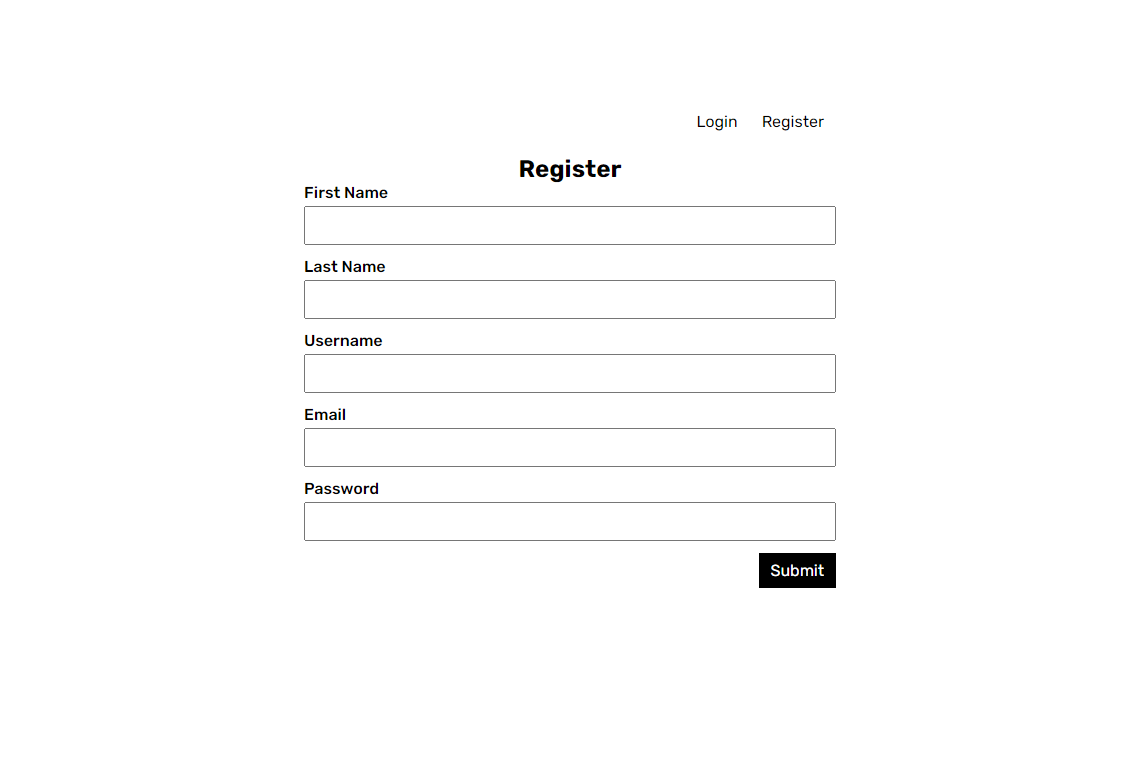
Set up Profile Page
To view and edit our profile, let's create edit-profile.component.ts file inside the app folder, then copy the code below:
import { Component, OnInit } from '@angular/core';
import { Router } from '@angular/router';
import { KontenbaseService } from './kontenbase.service';
@Component({
template: `
<div class="profile-page">
<div class="button-top">
<a [routerLink]="'/' + user.username" class="button">View Profile</a>
<button (click)="handleLogout()">Logout</button>
</div>
<div class="profile-wrapper">
<div class="profile-header">
<label class="label-file" for="file">
<img
class="image-avatar"
width="90"
height="90"
[src]="profile.image || 'https://via.placeholder.com/90'"
alt=""
/>
<span>{{ loading ? 'Uploading...' : 'Change Image' }}</span>
</label>
<input
name="file"
id="file"
type="file"
accept="image/*"
(change)="handleChangeImage($event)"
/>
</div>
<div class="card">
<form method="post">
<div class="card-field">
<label>First Name</label>
<input
#firstName
type="text"
name="firstname"
[value]="user?.firstName ?? ''"
/>
</div>
<div class="card-field">
<label>Last Name</label>
<input
#lastName
type="text"
name="lastname"
[value]="user?.lastName ?? ''"
/>
</div>
<div class="card-field">
<label>Phone Number</label>
<input
#phoneNumber
type="text"
name="phonenumber"
[value]="user?.phoneNumber ?? ''"
/>
</div>
<div class="card-field">
<label>Company</label>
<input
#company
type="text"
name="company"
[value]="profile?.company ?? ''"
/>
</div>
<div class="card-field">
<label>Position</label>
<input
#position
type="text"
name="position"
[value]="profile?.position ?? ''"
/>
</div>
<div class="card-field">
<label>Location</label>
<input
#location
type="text"
name="location"
[value]="profile?.location ?? ''"
/>
</div>
<div class="card-field">
<label>Website</label>
<input
#website
type="url"
name="website"
[value]="profile?.website ?? ''"
/>
</div>
<div class="form-button">
<button
type="submit"
(click)="
handleUpdate(
firstName.value,
lastName.value,
phoneNumber.value,
company.value,
location.value,
position.value,
website.value
)
"
class="button button-primary"
>
Update
</button>
</div>
</form>
</div>
</div>
</div>
`,
})
export class EditProfileComponent implements OnInit {
user: any;
profile: any;
loading = false;
constructor(
private readonly kontenbase: KontenbaseService,
private router: Router
) {}
ngOnInit() {
this.getProfile();
}
getProfile = async () => {
const { error, user } = await this.kontenbase.getOwnProfile();
if (error) {
console.log(error);
return;
}
if (user) {
this.user = user;
this.profile = user.profile[0];
}
};
handleChangeImage = async (event: any) => {
this.loading = true;
const file = event.target.files[0];
const { data, error: uploadError } = await this.kontenbase.uploadImage(
file
);
const { error: updateError } = await this.kontenbase.updateImage(
this.profile._id,
data?.url
);
if (uploadError || updateError) {
alert('Failed to change image profile');
return;
}
this.profile.image = data?.url;
this.loading = false;
};
handleUpdate = async (
firstName: string,
lastName: string,
phoneNumber: string,
company: string,
location: string,
position: string,
website: string
) => {
const { error: userError } = await this.kontenbase.updateUser(
firstName,
lastName,
phoneNumber
);
const { error: profileError } = await this.kontenbase.updateProfile(
this.profile._id,
company,
position,
location,
website
);
if (userError || profileError) {
alert('Failed to update profile');
} else {
alert('Profile updated!');
}
};
handleLogout = async () => {
await this.kontenbase.logout();
this.router.navigate(['/']);
};
}
declaration and Create a route for Edit Profile page.
import { NgModule } from '@angular/core';
import { RouterModule, Routes } from '@angular/router';
import { HomeComponent } from './home.component';
import { EditProfileComponent } from './edit-profile.component';
const routes: Routes = [
{
path: '',
component: HomeComponent,
},
{
path: 'profile',
component: EditProfileComponent,
},
];
@NgModule({
imports: [RouterModule.forRoot(routes)],
exports: [RouterModule],
})
export class AppRoutingModule {}
import { NgModule } from '@angular/core';
import { FormsModule, ReactiveFormsModule } from '@angular/forms';
import { BrowserModule } from '@angular/platform-browser';
import { AppRoutingModule } from './app-routing.module';
import { AppComponent } from './app.component';
import { LoginComponent } from './parts/login.component';
import { RegisterComponent } from './parts/register.component';
import { HomeComponent } from './home.component';
import { EditProfileComponent } from './edit-profile.component';
@NgModule({
declarations: [
AppComponent,
LoginComponent,
RegisterComponent,
HomeComponent,
EditProfileComponent,
],
imports: [BrowserModule, AppRoutingModule, FormsModule, ReactiveFormsModule],
providers: [],
bootstrap: [AppComponent],
})
export class AppModule {}
If we register or login successfully we should be navigated to Profile page. In this page we will able to edit profile and upload a picture.
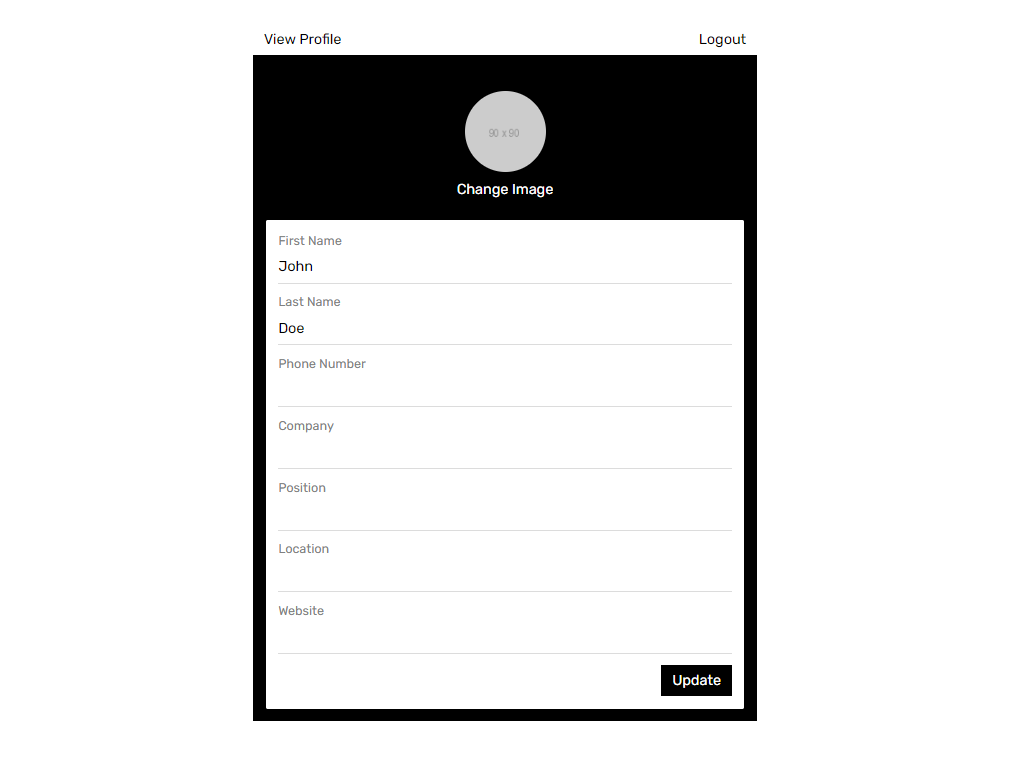
Set up View Profile Based on the Username
Now we will create a page to show user profile based on the username defined in the URL. Example when user visit: app_url/johndoe,
this page will show user profile with username johndoe.
Create profile.component.ts file inside the app folder, Copy the code below:
import { Component, OnInit } from '@angular/core';
import { ActivatedRoute, Router } from '@angular/router';
import { KontenbaseService } from './kontenbase.service';
@Component({
template: `
<div class="profile-page">
<div *ngIf="isOwnProfile" class="button-top">
<a routerLink="/profile" class="button">Edit Profile</a>
<button (click)="handleLogout()">Logout</button>
</div>
<div class="profile-wrapper">
<div class="profile-header">
<img
class="image-avatar"
width="90"
height="90"
[src]="profile.image || 'https://via.placeholder.com/90'"
alt=""
/>
<h3 class="profile-title">
<span>{{ user.firstName }}</span> <span>{{ user.lastName }}</span>
</h3>
<p>{{ profile.position || 'position is null' }}</p>
</div>
<div class="card">
<h3>Contact</h3>
<div class="card-field">
<span>Name</span>
<p>{{ user.firstName }} {{ user.lastName }}</p>
</div>
<div class="card-field">
<span>Mobile</span>
<p>{{ profile.phoneNumber || 'phone number is null' }}</p>
</div>
<div class="card-field">
<span>Email</span>
<a class="link-email" :href="'mailto:' + email">
{{ user.email || 'email is null' }}
</a>
</div>
<div class="card-field">
<span>Company</span>
<p>{{ profile.company || 'company is null' }}</p>
</div>
</div>
<div class="card">
<h3>Location</h3>
<p>{{ profile.location || 'location is null' }}</p>
</div>
<div class="card">
<h3>Web Links</h3>
<a class="website-link" href="{{ profile.website || '' }}">
Website
</a>
</div>
</div>
</div>
`,
})
export class ProfileComponent implements OnInit {
username: string | undefined;
user: any;
profile: any;
isOwnProfile = false;
constructor(
private readonly kontenbase: KontenbaseService,
private router: Router,
private route: ActivatedRoute
) {}
ngOnInit() {
this.username = this.route.snapshot.paramMap.get('username') || undefined;
this.getProfile();
}
getProfile = async () => {
const { data: userProfile, error } =
await this.kontenbase.getProfileByUsername(this.username);
if (error) {
console.log(error);
return;
}
const { user: authUser } = await this.kontenbase.getOwnProfile();
if (userProfile) {
this.user = userProfile[0];
this.profile = userProfile[0].profile[0];
this.isOwnProfile = this.user.username === authUser.username;
}
};
handleLogout = async () => {
await this.kontenbase.logout();
this.router.navigate(['/']);
};
}
Finally, declaration and create a route for this page.
import { NgModule } from '@angular/core';
import { RouterModule, Routes } from '@angular/router';
import { HomeComponent } from './home.component';
import { EditProfileComponent } from './edit-profile.component';
import { ProfileComponent } from './profile.component';
const routes: Routes = [
{
path: '',
component: HomeComponent,
},
{
path: 'profile',
component: EditProfileComponent,
},
{
path: ':username',
component: ProfileComponent,
},
];
@NgModule({
imports: [RouterModule.forRoot(routes)],
exports: [RouterModule],
})
export class AppRoutingModule {}
import { NgModule } from '@angular/core';
import { FormsModule, ReactiveFormsModule } from '@angular/forms';
import { BrowserModule } from '@angular/platform-browser';
import { AppRoutingModule } from './app-routing.module';
import { AppComponent } from './app.component';
import { LoginComponent } from './parts/login.component';
import { RegisterComponent } from './parts/register.component';
import { HomeComponent } from './home.component';
import { EditProfileComponent } from './edit-profile.component';
import { ProfileComponent } from './profile.component';
@NgModule({
declarations: [
AppComponent,
LoginComponent,
RegisterComponent,
HomeComponent,
EditProfileComponent,
ProfileComponent,
],
imports: [BrowserModule, AppRoutingModule, FormsModule, ReactiveFormsModule],
providers: [],
bootstrap: [AppComponent],
})
export class AppModule {}
And we're done to complete our App!
